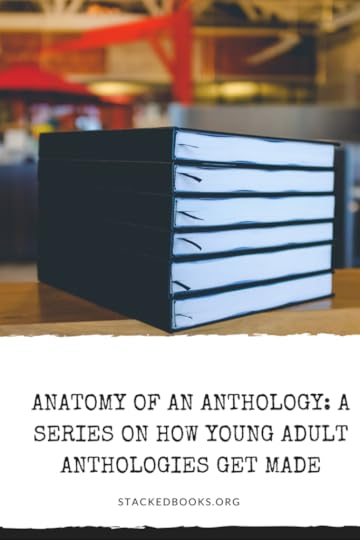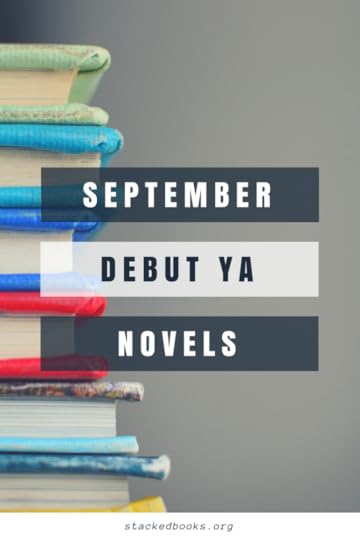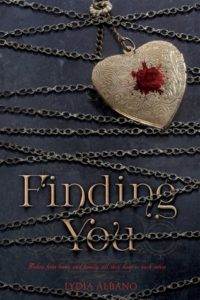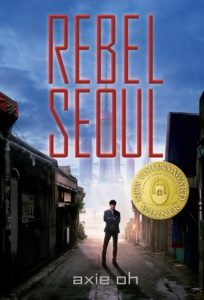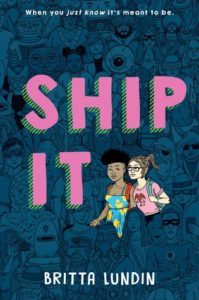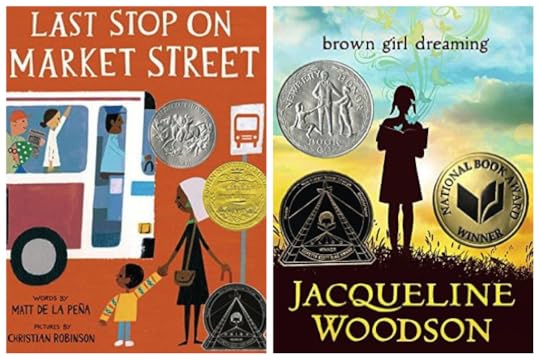Kelly Jensen's Blog, page 55
September 25, 2017
Anatomy of an Anthology: FERAL YOUTH edited by Shaun David Hutchinson
This week, we’re talking with Shaun David Hutchinson about editing YA anthologies. His most recent work is Feral Youth, which published earlier this month. This isn’t his only anthology though — more details below!
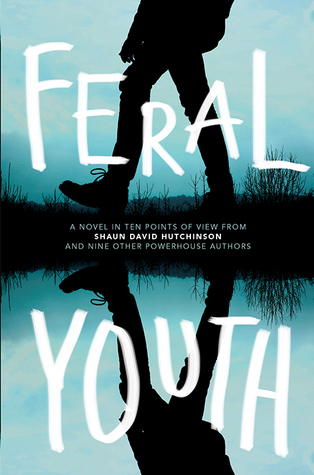 Your Name: Shaun David Hutchinson
Your Name: Shaun David Hutchinson
Your Anthology’s Name: Feral Youth
Anthology Description
At Zeppelin Bend, an outdoor-education program designed to teach troubled youth the value of hard work, cooperation, and compassion, ten teens are left alone in the wild. The teens are a diverse group who come all walks of life, and were all sent to Zeppelin Bend as a last chance to get them to turn their lives around. They’ve just spent nearly two weeks hiking, working, learning to survive in the wilderness, and now their instructors have dropped them off eighteen miles from camp with no food, no water, and only their packs, and they’ll have to struggle to overcome their vast differences if they hope to survive.
Inspired by The Canterbury Tales, the characters in Feral Youth, each complex and damaged in their own ways, are enticed to tell a story (or two) with the promise of a cash prize. The stories range from noir-inspired revenge tales to mythological stories of fierce heroines and angry gods. And while few of the stories are claimed to be based in truth, they ultimately reveal more about the teller than the truth ever could.
How did you get your idea/what was the initial spark?
I fell in love with The Canterbury Tales in college. I love, not just Chaucer’s writing, but the way he uses the stories his characters tell, as well as the interactions between the characters, to reveal their prejudices and fears and things they might not just come right out and say. Inspired by that, I wanted to create an anthology that revealed truths about a really diverse group of teens written by a talented group of diverse authors. The story of at-risk teens at an “Outward Bound” type camp was really inspired a lot by current events and with meeting teens from marginalized groups who expressed a powerful desire to see themselves in stories. I was also definitely inspired by the 2016 election when I sat down to write the frame story. I’d already had the direction I wanted to go before that happened, but the election changed the tone of what I ended up writing.
What steps did you take from idea to proposal?
The first thing (after discussing the concept with my agent) was to sketch out the idea so that I could approach authors. What that looked like was a summary of the concept along with what I would be expecting from them, what I’d be doing, and how that would all come together. My goal right then was to throw a line out there and see if authors would be interested. There’s not much point in spending time on a lengthy proposal if you can’t get authors interested.
My agent and I tossed around the author pitch and then put together a list of authors to email.
Once I had authors who had agreed tentatively to contribute, I started working on the more formal proposal.
What was included in your proposal to your publisher?
The proposal included the pitch, which was similar to what I’d sent the authors; the specifications of the anthology, word counts, number of stories, what I’d bring to the table in terms of marketing; what I think the market for the anthology is and how each author included fits into that; more detail on the marketing platform; any comp titles; and a potential author list.
The biggest part is really the pitch, but I believe it’s also important to make sure you know and can explain who the reader of this anthology is going to be and how each of your authors appeals to that market (or can expand upon it).
How did you find your writers?
Feral Youth is my second anthology. As with my first, I decided to reach out to authors whose work I knew. Sometimes those authors were friends, other times I only knew them by their work. For me, it was more important to find authors whom I thought would fit the tone and needs of the project. My goal was for the anthology to present stories about teens from diverse groups, so I also sought out authors from diverse groups. I wanted to offer as much representation as I could across these 10 stories. I also wanted writers with a wide range of styles. So after I’d created my dream list, I hunted down the email addresses of the authors I didn’t know personally, sent them a message, and hoped they’d agree to work with me.
To say I am humbled by the work this group of talented authors did is an understatement. I am so proud of the work they did.
As an editor, were you responsible for contracts between you and your writers? Did your publisher or agent handle the administrative/legal side of things?
It was a mix. My agent had put together an author agreement when we sold my first anthology, and we used that with some modifications for the second. I handled sending the agreements out, collecting them, and sending out checks. But my agent handled any questions the authors or their own agents had, and negotiated any changes to the agreements.
Money talk: how did you get paid?
I was paid by the publisher (through my agent).
How did your writers get paid?
I paid my authors directly.
What role did you take on as editor of the anthology? Were you hands on? Hands off?
I really like to give authors as much freedom to work as I can. With Violent Ends, I’d initially envisioned that all the stories would be from the point of view of victims of the shooter, but when the stories started coming in, the authors had really expanded the scope of the stories in ways I hadn’t thought of. They were brilliant, and I didn’t want to stifle that. The same with Feral Youth. I gave the authors broad direction in terms of what I was hoping for, and then let them run with it. When it came to actual editing, I offered my suggestions, but deferred to the authors’ judgement.
How did you communicate with your writers? What sort of information did you share with them and how?
We talked mostly via email. I did set up a collaboration board using Trello.com. We used it less for Feral Youth because there wasn’t as much direct collaboration as there had been for Violent Ends. I liked sharing who each of their characters were, the stories as they progressed. Because both of my anthologies were collaborative and existed in a shared world, I believed that the more information I shared with them about each other’s work would help them with their own.
Where and how did you decide to include your own work in the collection?
With Feral Youth, I knew from the outset that I was going to write the frame story. I certainly don’t consider myself anywhere near equal to Chaucer, but logistically it just made sense that I would write the frame seeing as I had access to all the stories and characters. Honestly, there was definitely a few moments where I questioned my ability to connect each of the brilliant stories in Feral Youth together. I wanted my frame story to be the connective tissue between the stories without getting in the way.
How involved was your editor/publisher throughout the creation process, prior to turning in a manuscript?
My editor was as involved as I needed her to be. She gave me the freedom to do the work as I felt it needed to be done, but was always willing to look at, not only the stories, but also my notes on the stories. One of the hardest things I’ve found about editing anthologies is that I can’t edit them the way I edit my own stories because they’re not my stories. So the suggestions I made had to be in line with the spirit of the work. My editor at Simon Pulse, Liesa Abrams, was wonderful about making sure I kept my editorial notes within that framework.
What was your favorite part of the anthology creation process?
Being the first person to read new stories by my favorite authors. Also, putting them all together into a coherent narrative and reading through that for the first time.
What was your least favorite part?
Copyediting. I dislike copyediting to begin with, but each author has a different style, and a copyeditor will want smooth out those differences to that the anthology feels consistent. So there’s a lot of work deciding where consistency should trump style and where an author’s individual style is more important than consistency.
September 24, 2017
September 2017 Debut YA Novels
It’s time for another round-up of debut YA novels of the month — here’s what we’ve got for September.
This round-up includes debut novels, where “debut” is in its purest definition. These are first-time books by first-time authors. I’m not including books by authors who are using or have used a pseudonym in the past or those who have written in other categories (adult, middle grade, etc.) in the past. Authors who have self-published are not included here either.
All descriptions are from Goodreads, unless otherwise noted; I’ve found Goodreads descriptions to offer better insight to what a book is about over WorldCat. If I’m missing any debuts out in September from traditional publishers — and I should clarify that indie/small presses are okay — let me know in the comments.
As always, not all noted titles included here are necessarily endorsements for those titles. List is arranged alphabetically by title, with pub dates beside them. Starred titles are the beginning of a new series.
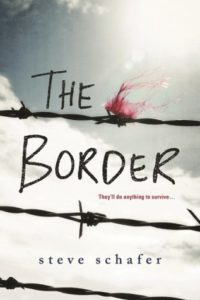 The Border by Steve Schafer (9/5)
The Border by Steve Schafer (9/5)
One moment changed their lives forever.
A band plays, glasses clink, and four teens sneak into the Mexican desert, the hum of celebration receding behind them.
Crack. Crack. Crack.
Not fireworks―gunshots. The music stops. And Pato, Arbo, Marcos, and Gladys are powerless as the lives they once knew are taken from them.
Then they are seen by the gunmen. They run. Except they have nowhere to go. The narcos responsible for their families’ murders have put out a reward for the teens’ capture. Staying in Mexico is certain death, but attempting to cross the border through an unforgiving desert may be as deadly as the secrets they are trying to escape
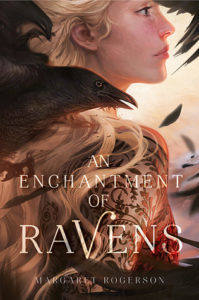 An Enchantment of Ravens by Margaret Rogerson (9/26)
An Enchantment of Ravens by Margaret Rogerson (9/26)
Isobel is a prodigy portrait artist with a dangerous set of clients: the sinister fair folk, immortal creatures who cannot bake bread, weave cloth, or put a pen to paper without crumbling to dust. They crave human Craft with a terrible thirst, and Isobel’s paintings are highly prized among them. But when she receives her first royal patron—Rook, the autumn prince—she makes a terrible mistake. She paints mortal sorrow in his eyes – a weakness that could cost him his life.
Furious and devastated, Rook spirits her away to the autumnlands to stand trial for her crime. Waylaid by the Wild Hunt’s ghostly hounds, the tainted influence of the Alder King, and hideous monsters risen from barrow mounds, Isobel and Rook depend on one another for survival. Their alliance blossoms into trust, then love, violating the fair folks’ ruthless Good Law. There’s only one way to save both their lives, Isobel must drink from the Green Well, whose water will transform her into a fair one—at the cost of her Craft, for immortality is as stagnant as it is timeless.
Isobel has a choice: she can sacrifice her art for a future, or arm herself with paint and canvas against the ancient power of the fairy courts. Because secretly, her Craft represents a threat the fair folk have never faced in all the millennia of their unchanging lives: for the first time, her portraits have the power to make them feel.
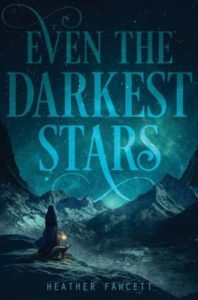 *Even The Darkest Stars by Heather Fawcett (9/5)
*Even The Darkest Stars by Heather Fawcett (9/5)
Kamzin has always dreamed of becoming one of the Emperor’s royal explorers, the elite climbers tasked with mapping the wintry, mountainous Empire and spying on its enemies. She knows she could be the best in the world, if only someone would give her a chance.
But everything changes when the mysterious and eccentric River Shara, the greatest explorer ever known, arrives in her village and demands to hire Kamzin—not her older sister Lusha, as everyone had expected—for his next expedition. This is Kamzin’s chance to prove herself—even though River’s mission to retrieve a rare talisman for the emperor means climbing Raksha, the tallest and deadliest mountain in the Aryas. Then Lusha sets off on her own mission to Raksha with a rival explorer who is determined to best River, and Kamzin must decide what’s most important to her: protecting her sister from the countless perils of the climb or beating her to the summit.
The challenges of climbing Raksha are unlike anything Kamzin expected—or prepared for—with avalanches, ice chasms, ghosts, and even worse at every turn. And as dark secrets are revealed, Kamzin must unravel the truth of their mission and of her companions—while surviving the deadliest climb she has ever faced.
Finding You by Lydia Albano (9/19)
Isla is kidnapped from a train platform in broad daylight, and thrust into a nightmare when she is sold to a sadistic aristocrat. Locked in a dungeon with a dozen other girls, Isla’s only comfort is a locket and the memory of the boy she loves. But as days pass and more girls disappear, she realizes that help is not coming… If they’re going to survive, they’ll have to escape on their own.
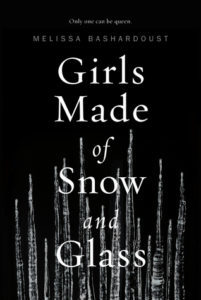 Girls Made of Snow and Glass by Melissa Bashardoust (9/5)
Girls Made of Snow and Glass by Melissa Bashardoust (9/5)
At sixteen, Mina’s mother is dead, her magician father is vicious, and her silent heart has never beat with love for anyone—has never beat at all, in fact, but she’d always thought that fact normal. She never guessed that her father cut out her heart and replaced it with one of glass. When she moves to Whitespring Castle and sees its king for the first time, Mina forms a plan: win the king’s heart with her beauty, become queen, and finally know love. The only catch is that she’ll have to become a stepmother.
Fifteen-year-old Lynet looks just like her late mother, and one day she discovers why: a magician created her out of snow in the dead queen’s image, at her father’s order. But despite being the dead queen made flesh, Lynet would rather be like her fierce and regal stepmother, Mina. She gets her wish when her father makes Lynet queen of the southern territories, displacing Mina. Now Mina is starting to look at Lynet with something like hatred, and Lynet must decide what to do—and who to be—to win back the only mother she’s ever known…or else defeat her once and for all.
Entwining the stories of both Lynet and Mina in the past and present, Girls Made of Snow and Glass traces the relationship of two young women doomed to be rivals from the start. Only one can win all, while the other must lose everything—unless both can find a way to reshape themselves and their story.
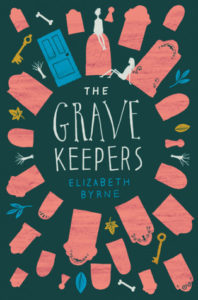 The Grave Keepers by Elizabeth Byrne (9/12)
The Grave Keepers by Elizabeth Byrne (9/12)
Lately, Athena Windham has been spending all her spare time in her grave.
Her parents—owners of a cemetery in Upstate New York—are proud of her devoutness, but her younger sister, Laurel, would rather spend her time exploring the forest that surrounds the Windham’s’ property than in her own grave.
The Windham girls lead secluded lives—their older sister died in a tragic accident and their parents’ protectiveness has made the family semi-infamous.
As the new school year begins, the outside world comes creeping in through encounters with mean girls, a new friend, and a runaway boy hiding out in the cemetery. Meanwhile, a ghost hangs around the Windham property—the only grave keeper never to cross over—plotting how to keep the sisters close to home and close to her . . . forever.
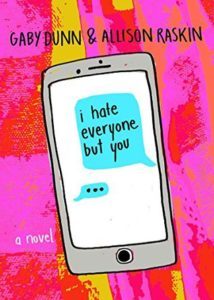 I Hate Everyone But You by Gaby Dunn and Allison Raskin (9/5)
I Hate Everyone But You by Gaby Dunn and Allison Raskin (9/5)
Dear Best Friend,
I can already tell that I will hate everyone but you.
Sincerely,
Ava Helmer
(that brunette who won’t leave you alone)
We’re still in the same room, you weirdo.
Stop crying.
G
So begins a series of texts and emails sent between two best friends, Ava and Gen, as they head off to their first semesters of college on opposite sides of the country. From first loves to weird roommates, heartbreak, self-discovery, coming out and mental health, the two best friends will document every moment to each other. But as each changes and grows into her new life, will their friendship be able to survive the distance?
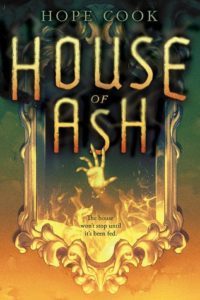 House of Ash by Hope Cook (9/26)
House of Ash by Hope Cook (9/26)
After hearing voices among an eerie copse of trees in the woods, seventeen-year-old Curtis must confront his worst fear: that he has inherited his father’s mental illness. A desperate search for answers leads him to discover Gravenhearst, a labyrinth mansion that burned down in 1894. When he locks eyes with a steely Victorian girl in a forgotten mirror, he’s sure she’s one of the fire’s victims. If he can unravel the mystery, he can save his sanity . . . and possibly the girl who haunts his dreams.
But more than 100 years in the past, the girl in the mirror is fighting her own battles. When her mother disappears and her sinister stepfather reveals his true intentions, Mila and her sister fight to escape Gravenhearst and unravel the house’s secrets—before it devours them both.
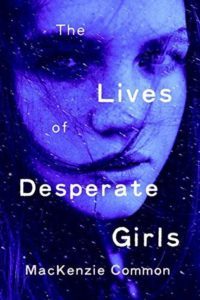 The Lives of Desperate Girls by MacKenzie Common (9/19)
The Lives of Desperate Girls by MacKenzie Common (9/19)
Sixteen-year-old Helen Commanda is found dead just outside Thunder Creek, Ontario. Her murder goes unremarked, except for the fact that it may shed light on the earlier disappearance of Chloe Shaughnessy. Chloe is beautiful, rich and white. Helen is plain, and from the reservation. They had nothing in common except that they were teenage girls from an unforgiving small town. Only Chloe’s best friend Jenny Parker knows exactly how unforgiving, but she’s keeping some dangerous secrets of her own.
Jenny begins looking for answers about Helen’s life and death, trying to understand larger questions about her town and her best friend. But what can a teenage girl really accomplish where adults have failed? And how much is Jenny actually complicit in a conspiracy of silence?
 Nyxia by Scott Reintgen (9/12)
Nyxia by Scott Reintgen (9/12)
Emmett Atwater isn’t just leaving Detroit; he’s leaving Earth. Why the Babel Corporation recruited him is a mystery, but the number of zeroes on their contract has him boarding their lightship and hoping to return to Earth with enough money to take care of his family.
Forever.
Before long, Emmett discovers that he is one of ten recruits, all of whom have troubled pasts and are a long way from home. Now each recruit must earn the right to travel down to the planet of Eden—a planet that Babel has kept hidden—where they will mine a substance called Nyxia that has quietly become the most valuable material in the universe.
But Babel’s ship is full of secrets. And Emmett will face the ultimate choice: win the fortune at any cost, or find a way to fight that won’t forever compromise what it means to be human.
After a great war, the East Pacific is in ruins. In brutal Neo Seoul, where status comes from success in combat, ex-gang member Lee Jaewon is a talented pilot rising in the ranks of the academy. Abandoned as a kid in the slums of Old Seoul by his rebel father, Jaewon desires only to escape his past and prove himself a loyal soldier of the Neo State.
When Jaewon is recruited into the most lucrative weapons development division in Neo Seoul, he is eager to claim his best shot at military glory. But the mission becomes more complicated when he meets Tera, a test subject in the government’s supersoldier project. Tera was trained for one purpose: to pilot one of the lethal God Machines, massive robots for a never-ending war.
With secret orders to report on Tera, Jaewon becomes Tera’s partner, earning her reluctant respect. But as respect turns to love, Jaewon begins to question his loyalty to an oppressive regime that creates weapons out of humans. As the project prepares to go public amidst rumors of a rebellion, Jaewon must decide where he stands—as a soldier of the Neo State, or a rebel of the people.
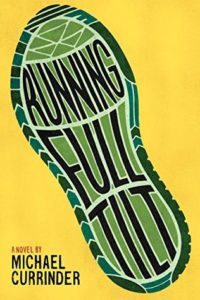 Running Full Tilt by Michael Currinder (9/5)
Running Full Tilt by Michael Currinder (9/5)
Like most siblings, Leo and Caleb have a complicated relationship. But Caleb’s violent outbursts literally send Leo running. When the family is forced to relocate due to Caleb’s uncontrollable behavior, Leo tries to settle into a new school, joining the cross-country team and discovering his talent for racing and endurance for distance. Things even begin to look up for Leo when he befriends Curtis, a potential state champion who teaches Leo strategy and introduces him to would-be girlfriend, Mary. But Leo’s stability is short-lived as Caleb escalates his attacks on his brother, resentful of his sport successes and new friendships.
Leo can’t keep running away from his problems. But, with a little help from Curtis and Mary, he can appreciate his worth as a brother and his own capacity for growth, both on and off the field.
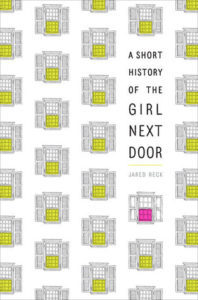 A Short History of The Girl Next Door by Jared Reck (9/26)
A Short History of The Girl Next Door by Jared Reck (9/26)
Fifteen-year-old Matt Wainwright is in turmoil. He can’t tell his lifelong best friend, Tabby, how he really feels about her; his promising basketball skills are being overshadowed by his attitude on the court, and the only place he feels normal is in English class, where he can express his inner thoughts in quirky poems and essays. Matt is desperately hoping that Tabby will reciprocate his feelings; but then Tabby starts dating Liam Branson, senior basketball star and all-around great guy. Losing Tabby to Branson is bad enough; but, as Matt soon discovers, he’s close to losing everything that matters most to him.
Humorous and heart-wrenching, A Short History of the Girl Next Door is perfect for readers who fell in love with All the Bright Places’ Finch or Stargirl’s Leo.
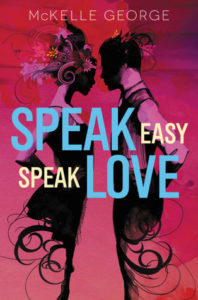 Speak Easy, Speak Love by McKelle George (9/19)
Speak Easy, Speak Love by McKelle George (9/19)
Six teenagers’ lives intertwine during one thrilling summer full of romantic misunderstandings and dangerous deals in this sparkling retelling of Shakespeare’s Much Ado About Nothing.
After she gets kicked out of boarding school, seventeen-year-old Beatrice goes to her uncle’s estate on Long Island. But Hey Nonny Nonny is more than just a rundown old mansion. Beatrice’s cousin, Hero, runs a struggling speakeasy out of the basement—one that might not survive the summer. Along with Prince, a poor young man determined to prove his worth; his brother John, a dark and dangerous agent of the local mob; Benedick, a handsome trust-fund kid trying to become a writer; and Maggie, a beautiful and talented singer; Beatrice and Hero throw all their efforts into planning a massive party to save the speakeasy. Despite all their worries, the summer is beautiful, love is in the air, and Beatrice and Benedick are caught up in a romantic battle of wits that their friends might be quietly orchestrating in the background.
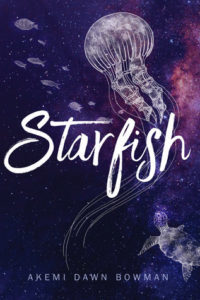 Starfish by Akemi Dawn Bowman (9/26)
Starfish by Akemi Dawn Bowman (9/26)
Kiko Himura has always had a hard time saying exactly what she’s thinking. With a mother who makes her feel unremarkable and a half-Japanese heritage she doesn’t quite understand, Kiko prefers to keep her head down, certain that once she makes it into her dream art school, Prism, her real life will begin.
But then Kiko doesn’t get into Prism, at the same time her abusive uncle moves back in with her family. So when she receives an invitation from her childhood friend to leave her small town and tour art schools on the west coast, Kiko jumps at the opportunity in spite of the anxieties and fears that attempt to hold her back. And now that she is finally free to be her own person outside the constricting walls of her home life, Kiko learns life-changing truths about herself, her past, and how to be brave.
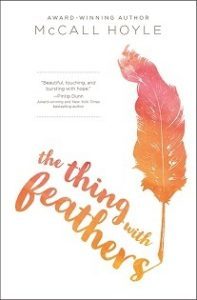 The Thing With Feathers by McCall Hoyle (9/5)
The Thing With Feathers by McCall Hoyle (9/5)
Emilie Day believes in playing it safe: she’s homeschooled, her best friend is her seizure dog, and she’s probably the only girl on the Outer Banks of North Carolina who can’t swim.
Then Emilie’s mom enrolls her in public school, and Emilie goes from studying at home in her pj’s to halls full of strangers. To make matters worse, Emilie is paired with starting point guard Chatham York for a major research project on Emily Dickinson. She should be ecstatic when Chatham shows interest, but she has a problem. She hasn’t told anyone about her epilepsy.
Emilie lives in fear her recently adjusted meds will fail and she’ll seize at school. Eventually, the worst happens, and she must decide whether to withdraw to safety or follow a dead poet’s advice and “dwell in possibility.”
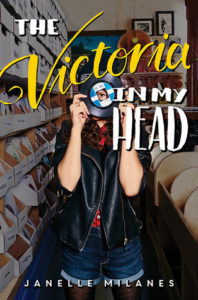 The Victoria In My Head by Janelle Milanes (9/19)
The Victoria In My Head by Janelle Milanes (9/19)
Victoria Cruz inhabits two worlds: In one, she is a rock star, thrashing the stage with her husky voice and purple-streaked hair. In the other, currently serving as her reality, Victoria is a shy teenager with overprotective Cuban parents, who sleepwalks through her life at the prestigious Evanston Academy. Unable to overcome the whole paralyzing-stage-fright thing, Victoria settles for living inside her fantasies, where nothing can go wrong and everything is set to her expertly crafted music playlists.
But after a chance encounter with an unattainably gorgeous boy named Strand, whose band seeks a lead singer, Victoria is tempted to turn her fevered daydreams into reality. To do that, she must confront her insecurities and break away from the treadmill that is her life. Suddenly, Victoria is faced with the choice of staying on the path she’s always known and straying off-course to find love, adventure, and danger.
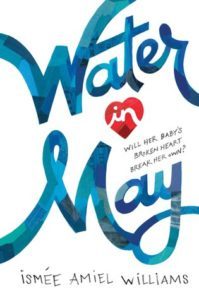 Water in May by Ismee Williams (9/12)
Water in May by Ismee Williams (9/12)
Fifteen-year-old Mari Pujols believes that the baby she’s carrying will finally mean she’ll have a family member who will love her deeply and won’t ever leave her—not like her mama, who took off when she was eight; or her papi, who’s in jail; or her abuela, who wants as little to do with her as possible. But when doctors discover a potentially fatal heart defect in the fetus, Mari faces choices she never could have imagined.
Surrounded by her loyal girl crew, her off-and-on boyfriend, and a dedicated doctor, Mari navigates a decision that could emotionally cripple the bravest of women. But both Mari and the broken-hearted baby inside her are fighters; and it doesn’t take long to discover that this sick baby has the strength to heal an entire family.
September 21, 2017
This Week at Book Riot
Over on Book Riot this week…
A look at 2017 YA debut novels you might have missed
Book Riot launched a brand new podcast dedicated to all things YA, and it’s hosted by Eric Smith and myself! Tune in to the first episode and then subscribe through your favorite podcast listening service.
September 20, 2017
A Guide To Incorporating HERE WE ARE: FEMINISM FOR THE REAL WORLD Into Classroom and Library Discussions/Curriculum
An impetus for beginning the “Anatomy of a YA Anthology” series came from being asked a lot of questions about the anthology process while promoting the book when it first released. I got so many great questions that led me to want to know more about the process behind other author’s anthologies.
Another thing that I got asked in numerous places was if I would consider putting together some kind of discussion guide for Here We Are: Feminism For The Real World that could be used in classrooms and libraries. There is a reading group discussion guide available through Reading Group Choices, which I wrote and you can access here, but this sort of resource would be different. It would give concrete ideas for incorporating the book into classroom (or library) discussions, with places where individual essays could be paired with other topics of study in neat, creative, and thought-provoking ways.
Today, I bring that guide.
This resource guide is built in two different ways, in order to accommodate a wealth of ways to incorporate the book — or even pieces of it — into current curriculum. First, I’ve pulled together the general ways that the book fits within Common Core standards for literacy and for writing across a range of subjects and topics. Second, I’ve created a means of looking at each individual essay, the themes presented, possible discussion/writing ideas, and ways those essays may be worth looking at in conjunction with common class reading/study topics. It would be impossible to make a guide to cover every possible scenario, so this is a broad guide, but I’ve written in such a way to make it easy to search by topic/area of interest.
The guide focuses Common Core alignments with 9-10 and 11-12 grade, but these are easily applied to grades 6-8, as well. Likewise, I have selected not to repeat the questions from the Reading Group Choices guide, though those would allow a lot of opportunity in meeting literacy standards for writing.
If you’d like a downloadable version of this guide, you can access it here.
Here We Are: Feminism For The Real World Common Core Standards
CCSS.ELA.RI.9-10.1, 9-10.2, 9-10.3
CCSS.ELA.RI.9-10.4, 9-10.5, 9-10.6
CCSS.ELA.RI.9-10.7, 9-10.8
CCSS.ELA.RI.11-12.1, 11-12.2, 11-12.3
CCSS.ELA.RI.11-12.4, 11-12.5, 11-12.6
CCSS.ELA.RI.11-12.7
All CCSS.ELA-Literacy.W.9-10, 11-12 all.
CCSS.ELA-Literacy.SL.9-10.1, 9-10.2, 9-10.3, 9-10.4
CCSS.ELA-Literacy.SL.11-12.1, 11-12.2, 11-12.3, 11-12.4
CCSS.ELA-LITERACY.L.9-10, 11-12 all.
CCSS.ELA-LITERACY.RH.9-10.1, 9-10.2, 9-10.3, 9-10.4, 9-10.5, 9-10.6, 9-10.7, 9-10.8, 10.9
CCSS.ELA-LITERACY.RH.11-12.1, 11-12.2, 11-12.3, 11-12.4, 11-12.5, 11-12.6, 11-12.7, 11-12.8, 11-12.9
CCSS.ELA-LITERACY.WHST.9-10, 11-12 all.
Select Big Picture Topics and Themes For Exploration in Here We Are: Feminism For The Real World
How can art be used to make a statement?
Which pieces of art from this book would be hanging on the walls of various literary or historical figures and why?
Words like “feminism” seem straightforward but they’re quite complex. How does this book highlight the similarities and differences among different people about what feminism is and is not?
How does the format of a piece of writing impact the tone and the message within it?
What is the purpose of a personal essay? Where and how does it tell a story? Why do people choose to write about their own experiences?
Can personal essays be persuasive?
Read the different voices represented in this collection as a means of staff enrichment or development, as the range of experiences included here mirror today’s students.
Topics, Themes, and Ideas To Explore Within Each Piece of Here We Are: Feminism For The Real World
Each essay below is listed with general themes and topics for discussion and writing purposes. Most, if not all, of the essays could easily be worked into research within and across a variety of areas. Likewise, almost all of these authors are published in a variety of formats, from online journals to novels to well-established and award-winning nonfiction. There is excellent opportunity for author studies on any of the writers, as well as excellent opportunity to introduce new works by them to students who may enjoy what they read here.
Forever Feminist by Malinda Lo
Write about characters who have stuck with you or influenced your life.
Explore classic feminists in literature — current and historic.
The power of history and family history, particularly as it relates to refugee families.
China and World War II.
Author/Book connections: Madeleine L’Engle, Edna St. Vincent Millay, Little Women.
What Does “Feminism” Mean? A Brief History of the Word, from Its Beginnings All the Way up to the Present by Suzannah Weiss
Explore the idea of etymology.
How and why do the meanings of words change over time?
Does knowing the evolution of the word “feminism” change how you read and explore the idea in classic literature? In early feminist texts?
How has our idea of feminism evolved alongside or counter to the word’s evolution?
Research project idea: find early uses of a common word in primary/secondary sources and how it has changed (or not!) over time.
How has social media impacted the meanings that words have?
Bad Feminist: Take Two by Roxanne Gay (originally published in Gay’s essay collection Bad Feminist)
What makes a feminist “good” or “bad?”
What defines the idea of “good” and “bad?”
Identify a single strong female character and analyze why/how they are “good” or “bad” feminists. Compare them with other strong female characters.
Examine the tone of Gay’s piece and how it effects the overall theme and takeaways of the essay.
Privilege by Matt Nathanson
Analyze a selection of advertisements in print and in other forms of media to determine the messages sent to male vs. female readers. Consider and write about who those ads are really meant to reach.
What messages do girls and boys each receive growing up that creates a self-esteem gap? Where do those messages come from?
Identify and explore examples of male feminists through literature. What does or does not make them feminist?
What does “privilege” mean?
The Monster Book of Questions and Answers by Anne Thériault
How and why is mental illness a feminist issue?
Explore “what if” scenarios relating to well-known examples of those in history and literature who suffered mental illness. For example: what if Vincent Van Gogh had better access to mental health help? Would Sylvia Plath have fared better or worse in today’s slightly-more-accepting climate of mental health?
Using the “Ten Amazing Scientists” list at the end of the article as a springboard to researching famous women in science and their enduring legacies. Tie-in to Hidden Figures and other recent media on women in science.
Pretty Enough by Alida Nugent
How does the use of humor help convey its theme? How can humor help structure an effective essay?
Talk about why we need diverse representation in literature and history.
What messages — subtle or not — are sent to people in our culture who don’t fit the typical mold of white beauty? How do we deconstruct that model of the “ideal” look?
So I Guess This Is Growing Up by Liz Prince
How can comics be like personal essays?
In what ways do comics convey information that traditional texts can’t or don’t?
Create your own comic about a moment in your life that was important OR create a comic based on a character in a book you’ve read recently.
I Have Always Eaten The Bread by Lily Myers
What does the phrase “this is the shape I make today” mean? How does it apply in your own life?
Examine the messaging of men’s and women’s magazines. What do the covers and articles suggest about bodies, health, and/or what’s “good shape” in each? Compare and contrast.
What’s the psychology behind advertising? What messages do advertisers hope to convey to people?
Read this one alongside “Privilege” by Matt Nathanson to talk about gender, sexism, and social messaging.
Dragging Myself Into Self-Love by Constance Augusta Zaber
What are gender roles? Where do they come from and in what ways do they come into and play a part in our everyday lives?
Pick a fictional character or historical figure who defied conventional gender norms.
Pick a living individual who defies gender norms and highlight the ways they’ve been a trailblazer within their respective area of expertise.
Discuss what “choice feminism” is as a topic and why it’s not key to being a feminist or understanding feminism more broadly.
Read this one alongside “I Have Always Eaten The Bread” by Lily Myers and “Privilege” by Matt Nathanson to talk about peer pressure, self-love, self-recognition, and gendered messaging.
The Likability Rule by Courtney Summers
Explain what “The Likability Rule” means, citing examples in books, music, movies, or other media.
Why do we label some characters as “unlikable?”
Create a list of unlikable male characters in literature and apply the “likability” standards to them as outlined in the essay. Where do they fail to fit? Do they have more leeway than similarly unlikable female characters?
Broken Body, Worthless Girl, and Other Lies I Called The Truth by Kayla Whaley
Where does the idea of desirability come from? What messages do we receive about what does or doesn’t make a person, place, or idea something we desire?
Dive into the history of a disabled author or person from history and talk about the great contributions they’ve made.
How does this piece’s format — a letter to one’s younger self — convey its message? In what ways is it more effective than a more traditional personal essay?
Use the format to inspire a creative writing project: have an adult character from literature or history write a letter to their younger selves with the lessons they’ve learned.
Pair with Siobhan Vivian’s essay and Erika T. Wurth’s essay for more in-depth discussion of letters as means of persuasion and writing styles/techniques.
All The Bodies by Rafe Posey
How does this essay expand and/or explore the Langston Hughes essay “My Life As A Social Poet?”
Why is “feminism” a loaded concept, as stated? In what ways can it become less loaded, if it can be?
How does reading help encourage empathy?
Do Female Black Lives Matter Too? by Amandla Stenberg
How are black women represented in the media? In literature? Through history? Cite examples of good and bad representation.
Where do we see black women in literature?
What black women authors should become part of the literary canon?
This short piece notes that “When the media is not ignoring black women all together, they are disparaging them.” What does that mean?
Research project: highlight the life of a black woman from history or literature who made an impact in their given field.
An Interview With Laverne Cox: “I Absolutely Consider Myself a Feminist” by Tricia Romano
Explore feminism and womanism as noted in the interview, including bell hooks and Kimberlee Crenshaw, noted academic who coined the term “intersectionality.”
Read and analyze “Ain’t I A Woman?” by bell hooks. How does Cox see herself in light of this poem?
Feminism Is As Feminism Does by Mia and Michaela DePrince
Read Michaela DePrince’s memoir Taking Flight and compare/contrast her story there with how she’s pursued helping others in her young life.
How do you pursue a passion?
What does global feminism look like? How do Western feminists help women (and other genders) throughout the world?
Research an organization dedicated to helping women in another country. What and why do they do what they do? How have they helped those communities?
Explore some of the further reading and resources included in this essay to learn more about the issue of female genital mutilation and sexual violence. Pair this essay and research with the interview about girls’ stories and sexual assault with Laurie Halse Anderson and Courtney Summers.
Mia’s song at the end of the piece highlights early feminists. Who are they, and how and why have they influenced her in her own feminism?
How is songwriting an effective means of conveying an idea?
Somewhere In America by Zariya Allen
Explore the history of censorship in America. Dig into what censorship does and does not mean?
Select a frequently banned book and research why it’s controversial. How does/doesn’t that differ from what we see on the news or in the media?
How is poetry and effective means of highlighting an idea or topic?
Pair with “Shrinking Woman” by Lily Myers to talk about slam poetry and oral storytelling.
Watch both this piece and Lily’s via YouTube and compare/contrast the impact of hearing vs. reading it.
Choose Your Own Adventure: Why Fandom Is Right For You (Yes, You!) by Brenna Clarke Gray
Develop your own fan fiction for a character in a classroom read.
Or, write a short piece of fan fiction from the voice of a character in a book you’ve read.
Read a selection of fan fiction and discuss how, where, and why it’s effective creative writing. What keeps you reading? What makes you stop?
Discuss how fandom impacts the what/how/ways we connect with books and stories.
Read a book, then explore a selection of fan fiction and/or fan art from it. Write about how the fan work sticks to or strays from the original work.
Facets of Feminism by Mikki Kendall
Who are your feminist icons and why?
Research the variety of women named in this essay — historical and contemporary — and explore where, why, and how they’ve had their feminism criticized.
In what ways have historical feminists criticized modern feminists of color? Where, why, and how has this happened?
How do we allow new, younger voices take the mic up about feminism?
Read Alice Walker’s views on womanism and talk about the difference between feminism and womanism.
Pick one of the women named in this essay and research her life.
Don’t Cash Crop On My Cornrows by Amandla Stenberg
Research the history of jazz and blues. How do those music genres relate to hip hop?
How has black culture been bought and sold?
Why does it matter to see and read diverse literature? What is the power of #ownvoices (stories written by marginalized people about those from their same marginalization) vs. those stories which are diverse but written by those outsize a particular marginalized group?
Create a visual or write a short essay on recent trends in popular culture which had their roots in black culture.
A Conversation About Girls’ Stories and Girls’ Voices with Laurie Halse Anderson and Courtney Summers by Kelly Jensen
Use this interview as part of a novel study with Speak and/or All The Rage.
Why is it that girls’ stories have been historically underrepresented?
Why is the Western literary canon primarily white men?
Explore rape culture as seen through classic literature. For example: How/where does The Scarlet Letter play into rape culture? Does the context of this story change some of its messaging?
Topics about women and literature abound: the use of male pen names, the meaning of genre vs. “literature,” and so forth.
Girl Lessons by Sarah McCarry
What messages might girls pull from the books that they read or the media they consume about how they should “be a girl?” About how they should relate to other girls?
Use this essay in conjunction with studies about gender norms and conformity.
The Princess and the Witch by Wendy Xu
What is cultural fetishization? Cite examples through modern and historical times.
Use this comic to discuss the power of comics as a medium of storytelling and information sharing.
How does this comic relate to Xu’s note on being fascinated with “Beauty and the Beast” while growing up?
Pull this piece with “Feminism is as Feminism Does” by the DePrince sisters, as well as with “Don’t Cash Crop On My Cornrows” by Amandla Stenberg to talk about global feminism, as well as cultural identity.
Compare and contrast Xu’s story about growing up as an Asian American with the experiences that Malinda Lo shares in her essay “Forever Feminist.”
Corny Won’t Kill Your Cred: Rearview Mirror Reflections on Feminism and Romance by Siobhan Vivian
Cite examples of teen romance in books and in the greater media and explore what the messages they share might be. What might readers walk away with about the ideas of love and romance from them?
Tie in with Shakespeare’s Romeo and Juliet. What if Juliet had received a similar letter from her future self? What would change, if anything? Perhaps, going out on a limb, there’s an opportunity for Juliet to write a letter to her young self in an imagined world where she is still alive.
Compare and contrast the letter-style essay format with Kayla Whaley and Erika T. Wurths pieces.
Faith and the Feminist by Kay Mirza
Research project: explore famous Muslims in history, literature, and contemporary times.
Why does representation matter? How might Mirza’s experiences growing up have been influenced by seeing more Muslims in books and television?
Mirza’s essay explores the tensions between feminism — historical and modern — and her faith. In what ways have religion and other philosophies impacted history and/or literature?
Can one be religious and feminist? How does someone come to terms with some of their beliefs contradicting?
In Search of Sisterhood by Brandy Colbert
Where have you found sisters/brothers outside of your family? If you never have found a sister/brother in the world, why?
Research project: black women through history and/or literature.
Read in conjunction with Colbert’s novel Pointe and see where Colbert’s own shared experience appear in her novel.
Colbert wrote a list of great black girl friendships. Brainstorm and write about great black girl friendships in books.
A Feminist Love by Jessica Luther
What are some examples of messaging to women about romance?
Explore dating ads and the messages they present about gender and gender norms.
What and why are some couples seen as “power couples” through history or the media? Give examples.
How could the experiences Luther talks about in relation to her own marriage be useful in offering dating or romantic advice to literary characters?
The “Nice Girl” Feminist by Ashley Hope Pérez
Who are examples of “nice girls” in literature or history? What about in pop culture? What makes them “nice girls?”
Apply the tips of being a “nice girl” to a character in a book who might need it.
What are the differences and similarities between the “nice girl” and the “unlikable” girl? Are there equivalent labels for boys and other genders?
Shrinking Women by Lily Myers
Explore cultural messaging about women and self-esteem, especially as it relates to body image.
How and why is slam poetry and effective method for persuasion?
What characters or people from history would relate to this poem? How and why?
Pair with “Somewhere in America” and watch the performances of both poems on YouTube. How does the viewing experience differ from the reading experience of each of these poems?
Dear Teen Me: It Would Have Changed Everything; It Would Have Changed Nothing by Erika T. Wurth
Where and how do we typically learn about Native Americans? What sorts of stories are shared in the classroom and in popular media?
Why does representation matter? Tie this piece in with others on the same topic of representation and inclusivity.
Pair with reading Sherman Alexie’s Absolutely True Diary of a Part-Time Indian. How does Junior’s experience compare with Wurth’s, if at all?
A Thousand Paper Cuts by Shveta Thakrar
How do underrepresented voices get heard? How do the works of marginalized groups get read and shared?
How is writing a feminist act? How is writing a political act?
An excellent piece to talk about the writing process more broadly and might make for a solid first day reading for a writing-focused course and/or a solid piece of inspiration in similar classes.
The Win That Comes From Losing by Wendy Davis
Explore “losers” through history and what experiences or victories came in time for them.
Discuss: when is it okay to lose? What do we learn from failing to achieve something we set out to achieve?
When is it okay to quit? Is it ever okay to be a “quitter?”
Write about a character who has suffered a big loss and how they used that loss to motivate them on their journey.
Contemporary research project: what initiatives or activities has Davis participated in since her loss? How has she continued to be active and engaged in her community (both the small and big community)?
Many Stories, Many Roads by Daniel José Older
Research the quote that leads off the essay. Who is it credited to and why is it an important introduction to Older’s essay? How does it tie into what the essay explores?
Using the definition of “feminist” explored, discuss how various characters through literature have found their way to feminism.
Pair this essay with luminaries included within it: Audra Lorde, Chimamanda Ngozi Adichie, and Ta-Nehisi Coates.
At the end of the essay, Older talks about “the beautiful struggle.” What does that mean? How does it play out in history or literature?
Reading Worthy Women by Nova Ren Suma
Do we all need to read the same sorts of books to be considered “well-read?” What does being “well-read” mean?
Why is the Western literary canon predominantly straight white male authors?
What makes some books “literature” and others not? Why do some get studied in school and other titles don’t?
What female authors should be part of a reading curriculum? What five female authors should everyone read in high school English classes?
Pair with essays about representation and voice.
This essay would pair excellently with the first class read of a book by a female author.
The Choice Is Yours by Kody Keplinger
Why are children a symbol of achievement for women? Is it the same for men?
What, exactly, is selfishness? How is one act considered selfish and another not? Who decides the line between the two?
Explore literary and historical examples of when a choice made early in one’s life has had a huge impact on them, especially if it was a choice met with significant resistance.
A Guide To Being A Teenage Superheroine
Create your own superhero identity and make yourself into a comic to tell your story.
Create a superhero identity for famous heroes and villains through history and/or literature.
An easy “introduce yourself” activity for new classes, as well as a way to introduce new characters in a book — one part of a reading assignment could be to develop a series of superhero profiles for a book’s main characters.
Discuss superhero identities broadly: why do they matter? Why do we like them so much? Where and how is it okay for superhero identities to grow and evolve? Pair up with discussions about race and gender changes in superhero stories (like Miles Morales, Thor, etc.).
Pair with discussion of mythology.
Don’t Peak in High School by Mindy Kaling
Why does pop culture romanticize high school?
Culturally, what does high school represent? Where and how has the representation changed through history?
Explore images and renderings of high school and the growth of teen culture after World War II.
Why are high school experiences of people of color lacking in pop culture and history? Tie back into discussion within other essays about representation of diverse experiences in literature and pop culture.
Write about your own high school experience and how it is similar and different from an example in a song, a book, a movie, or a television show.
Owning My Feminism by Kelly Jensen
How are feminists portrayed through history and in popular culture?
Imagine the impostor syndrome literary or historical figures have experienced: what were they thinking or feeling during some of their biggest, scariest moments? What about in their quieter and still important moments?
How can you own your feminism?
____________________
I hope this helps those of you looking for ways to incorporate the book and/or parts of it into your curriculum. I’ve heard from a number of readers that they’ve incorporated the book into unique and creative discussions, and I’d love to hear more about how you’ve used Here We Are with teens (or adults!).
For those who are interested, I do offer free Skype visits for teachers or librarians using Here We Are. All of the details for doing that are available here, as are details about the non-fiction writing for teens program I offer more locally (Milwaukee, Madison, Chicago, and Rockford areas are all local to me). You can find my contact information there, too, and I’m happy to hear feedback or suggestions for this curriculum guide.
If you’d like a downloadable version of this guide, you can access it here.
September 18, 2017
Anatomy of an Anthology: WELCOME HOME edited by Eric Smith
Today’s edition of “Anatomy of an Anthology” comes from YA author/editor/fanboy Eric Smith. His first anthology, Welcome Home, was published by Flux and hit shelves September 5.
Your Anthology’s Name:
Welcome Home
Anthology Description: A YA short story collection centered around the theme of adoption.
How did you get your idea/what was the initial spark? My wife, really. She’d been trying to push me to write a little more seriously, focus on topics that were close to me. It always surprised her that I didn’t write about being an adoptee more, since it was something I talked about a lot and occasionally wrote an essay about. And as we discussed it more, it started to hit me how seldom I saw adopted characters in stories growing up.
Where did you begin researching your idea and/or developing the idea into a more clear, focused concept? I started looking at a lot of my favorite YA anthologies from the past few years, like Geektastic edited by Holly Black and Cecil Castellucci, Stephanie Perkins’ excellent My True Love Gave To Me, and those short-stories-from-hell collections with Libba Bray, Meg Cabot, Melissa Marr, and Kristin Cast.
I asked myself lots of questions. What did these books do so well? How many contributors did each collection have? I found myself emailing a lot of people that had been in collections like these, to see how they came together.
What steps did you take from idea to proposal? I brainstormed with my agent a bit, and then sent over a potential outline after emailing a bundle of author friends that I thought might be interested. We talked about what their stories might be, and once I had five people that were absolutely confirmed and a whole bundle, close to two dozen or so, that were a solid maybe, we built the proposal.
What was included in your proposal to your publisher? It was a pretty hefty proposal. We had an overview of what the book would be and why we thought it needed to exist, that was sort of a mashup of jacket-copy-meets-query-letter. We had a few pages that detailed confirmed and potential contributors, as well as some pages that talked about comparative titles that would share shelf space, like the anthologies I mentioned earlier.
We also dove into the platform brought on board by the authors in the collection, and what we could potentially do. Events together, pre-order campaigns, and the like. Spent a bit of time name dropping, authors and media folks we thought might potentially boost the project.
And then, there was the sample material. We didn’t have much, just a few quick blips that talked about the stories in-progress, as well as the stories that were already finished. I was lucky enough to have finished shorts from Adi Alsaid, Lauren Gibaldi, and Mindy McGinnis going out.
Did you use an agent? If you didn’t use an agent, how did you find a publisher? I did.
How did you find your writers? I’m lucky enough to be connected with some wonderful writer folks thanks to the joys of Twitter. I sent plenty of awkward DMs and emails. I wanted the collection to have a lot of stories from authors who had a close connection to adoption. Adopted themselves, had adopted kids or foster children, etc. The problem is that not everyone is popular enough to have like, a Wikipedia page where you can find this out.
So, there were a lot of odd emails that were like “hey so… this book about adoption… do you have any ties…” because you can’t just message someone and say “hey are you adopted?” Cause that’s just inappropriate. God knows people asked me that way too many times growing up, and I got in way too many fights as a result.
Eventually, I found a lot of my contributors as a result of people recommended other people and sending introductions.
How did writers pick their story or essay topic ideas? What process did you as editor use to vet them? I just asked them to pitch and write whatever they wanted, in whatever genre they wanted. I wanted the collection to talk about as many facets of the adoptee experience as possible, and there are a LOT of them. So I was careful to nudge people in this direction or that, so we didn’t get too many of the same story again and again.
As an editor, were you responsible for contracts between you and your writers? Did your publisher or agent handle the administrative/legal side of things? Luckily my agent and editor handled the contracts stuff. I talked a bit with the authors about things they wanted, and it was all really nice and open, and then my agent and editor handled the actual paperwork. When you have nearly 30 contributors… well, it’s a lot. I’m really thankful for them.
How did the editing process work between you and your writers? It was simple really. I just gave notes, line-edits and the like. In the end, my editor at Flux (hi McKelle!) gave the most detailed edits, really digging in and polishing the stories up. I did run into some challenges here on the editing end that made me extra grateful to have her in my corner. Because I’m really a fan first, and an editor second.
Like, how am I supposed to give editorial notes to authors I love so terribly?! EVERYTHING YOU HAVE DONE IS PERFECT, I want to scream. So thankfully McKelle could lend a more objective hand.
Money talk: how did you get paid for your work? I didn’t. There wasn’t an advance on my particular anthology, and when it comes to the royalties, we are planning to donate them to non-profits that support adoptees and foster youth. I’m excited for that first check and to see what good we can do.
What role did you take on as editor of the anthology? Were you hands on? Hands off? I was pretty hands-on. But once it went off to my editor at Flux, I just let them do their thing. I did a bunch of reading and re-reading once we had the digital files and ARCs, of course, and sent notes over when I had them.
How did you communicate with your writers? What sort of information did you share with them and how? Lots of emails. Probably to a fault. I hope they didn’t (and don’t) find me too annoying, but I definitely send out big ol’ BCC emails about postcards, events, and the like to everyone. They get all the details.
Where and how did you decide to include your own work in the collection? Pretty early on. I knew I wanted to tell an adoption story as an adoptee. Thing is, I’m not great at writing short stories and I know it. I had a lot of input from my fellow contributors, and they are all just wonderful.
Where and how did you come to “direct” the anthology? Did you have an idea of how you wanted pieces to progress early on or did you wait until all pieces were available to you to begin constructing the collection? I waited til we had some more pieces in. As they were coming in, I was able to ask myself what I was missing.
For example, at one point I realized I didn’t have any pieces about a teen parent and their adopted child. What is it like on that end of the story? Luckily, writers like Sangu Mandanna and Lauren Morrill penned stories along those lines, and they were so lovely.
How involved was your editor/publisher throughout the creation process, prior to turning in a manuscript? Very! They gave lots of notes on the stories I’d sent in initially, and bounced ideas back and forth. When some contributors couldn’t quite commit to a story anymore, due to deadlines on their other work, we talked about potential other people to reach out to. They were great.
When the manuscript was a complete draft, what was the process when you passed it on to your editor/publisher? I sent it on over almost immediately? I shared stories with the contributors and had some beta readers, but it pretty much went right there.
How did you communicate changes and/or concerns between writer and your editor/publisher? Just via email. They were really easy to work with.
When it came to the package of your anthology, how much say did you have in the cover or design? How much were contributors involved in that part of the process? Welcome Home actually had an entirely different cover before we moved over from Jolly Fish to Flux. It was one that I really adored, so I was a little bummed when they had to change direction. But the resulting cover, with its simplicity and just really clean look, was one I took to right away. We had a few other designs along the way that I was a little on the fence about, and they were very supportive when it came to changes and updates. The contributors weren’t involved, but I did bounce some of the covers off them when I could.
What was your favorite part of the anthology creation process? As cheesy as this might sound, finding more adoptees? People with links to adoption? Growing up I didn’t know many kids like me, and finding adults who I could finally talk to about this stuff felt so great. And reading the kind of stories I wanted so desperately as a kid… well, it filled my heart, that’s for sure.
What was your least favorite part? Saying no? I had a lot of people email to be in the collection, and I couldn’t say yes to everyone. That part was really rough.
What were some of the biggest successes? Seeing some of the trade reviews float in. My goodness, that has blown me away. And I’m hoping that this book will encourage more people to write stories of adoption.
If you aren’t already working on another anthology, would you do another one? Why/why not? It would have to be the right thing. This was something really close to me, and I’m hard pressed to think of another topic I’d so desperately want to cover. But maybe it’s out there. I’d certainly contribute to another anthology though, hint-hint-nudge-nudge to anyone who might be reading this that’s an author.
September 17, 2017
Teens of Color on 2018 YA Book Covers
One of my favorite annual round-ups has been this one: a look at the YA books hitting shelves in the next year featuring teens of color front and center. It’s been refreshing to see this become more common, though as always, we could use more, more, more.
Here’s a look at some excellent 2018 book covers where teens of color are front and center. Not all covers for next year’s books have been revealed yet, so this isn’t comprehensive. Grab your TBR and pop these right on it. All descriptions are from Goodreads.
Know of any I’ve missed from traditional publishers? Lay ’em in the comments.
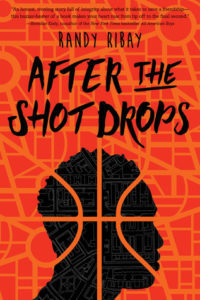 After The Shot Drops by Randy Ribay (March 6)
After The Shot Drops by Randy Ribay (March 6)
Bunny and Nasir have been best friends forever, but when Bunny accepts an athletic scholarship across town, Nasir is betrayed. Bunny feels out of place among his new, privileged peers, and Nasir spends more time with his cousin, Wallace, who is being evicted. Nasir can’t help but wonder why the neighborhood is falling over itself to help Bunny when Wallace is in trouble.
When Wallace makes a bet against Bunny, Nasir is faced with an impossible decision—maybe a dangerous one.
 American Panda by Gloria Chao (February 6)
American Panda by Gloria Chao (February 6)
At seventeen, Mei should be in high school, but skipping fourth grade was part of her parents’ master plan. Now a freshman at MIT, she is on track to fulfill the rest of this predetermined future: become a doctor, marry a preapproved Taiwanese Ivy Leaguer, produce a litter of babies.
With everything her parents have sacrificed to make her cushy life a reality, Mei can’t bring herself to tell them the truth–that she (1) hates germs, (2) falls asleep in biology lectures, and (3) has a crush on her classmate Darren Takahashi, who is decidedly not Taiwanese.
But when Mei reconnects with her brother, Xing, who is estranged from the family for dating the wrong woman, Mei starts to wonder if all the secrets are truly worth it. Can she find a way to be herself, whoever that is, before her web of lies unravels?
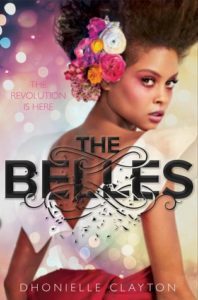 The Belles by Dhonielle Clayton (February 20, first in a series)
The Belles by Dhonielle Clayton (February 20, first in a series)
Camellia Beauregard is a Belle. In the opulent world of Orléans, Belles are revered, for they control Beauty, and Beauty is a commodity coveted above all else. In Orléans, the people are born gray, they are born damned, and only with the help of a Belle and her talents can they transform and be made beautiful.
But it’s not enough for Camellia to be just a Belle. She wants to be the favorite—the Belle chosen by the Queen of Orléans to live in the royal palace, to tend to the royal family and their court, to be recognized as the most talented Belle in the land. But once Camellia and her Belle sisters arrive at court, it becomes clear that being the favorite is not everything she always dreamed it would be. Behind the gilded palace walls live dark secrets, and Camellia soon learns that the very essence of her existence is a lie—that her powers are far greater, and could be more dangerous, than she ever imagined. And when the queen asks Camellia to risk her own life and help the ailing princess by using Belle powers in unintended ways, Camellia now faces an impossible decision.
With the future of Orléans and its people at stake, Camellia must decide—save herself and her sisters and the way of the Belles—or resuscitate the princess, risk her own life, and change the ways of her world forever.
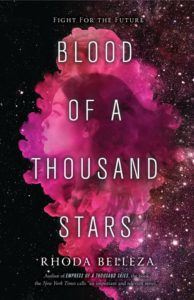 Blood Of A Thousand Stars by Rhoda Belleza (February 20, second in a series)
Blood Of A Thousand Stars by Rhoda Belleza (February 20, second in a series)
Empress
With a revolution brewing, Rhee is faced with a choice: make a deal with her enemy, Nero, or denounce him and risk losing her crown.
Fugitive
Framed assassin Alyosha has one goal in mind: kill Nero. But to get his revenge, Aly may have to travel back to the very place he thought he’d left forever—home.
Princess
Kara knows that a single piece of technology located on the uninhabitable planet Wraeta may be the key to remembering—and erasing—the princess she once was.
Madman
Villainous media star Nero is out for blood, and he’ll go to any means necessary to control the galaxy.
Vicious politics and high-stakes action culminate in an epic showdown that will determine the fate of the universe.
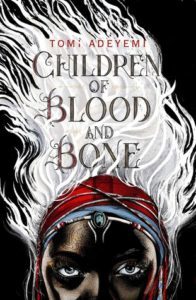 Children of Blood and Bone by Tomi Adeyemi (March 6, first in a series)
Children of Blood and Bone by Tomi Adeyemi (March 6, first in a series)
Zélie Adebola remembers when the soil of Orïsha hummed with magic. Burners ignited flames, Tiders beckoned waves, and Zelie’s Reaper mother summoned forth souls.
But everything changed the night magic disappeared. Under the orders of a ruthless king, maji were targeted and killed, leaving Zélie without a mother and her people without hope.
Now, Zélie has one chance to bring back magic and strike against the monarchy. With the help of a rogue princess, Zélie must outwit and outrun the crown prince, who is hell-bent on eradicating magic for good.
Danger lurks in Orïsha, where snow leoponaires prowl and vengeful spirits wait in the waters. Yet the greatest danger may be Zélie herself as she struggles to control her powers—and her growing feelings for the enemy.
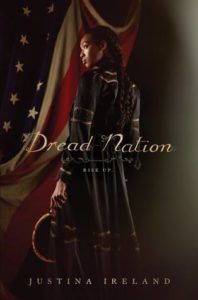 Dread Nation by Justina Ireland (April 3)
Dread Nation by Justina Ireland (April 3)
Jane McKeene was born two days before the dead began to walk the battlefields of Gettysburg and Chancellorsville—derailing the War Between the States and changing America forever. In this new nation, safety for all depends on the work of a few, and laws like the Native and Negro Reeducation Act require certain children attend combat schools to learn to put down the dead. But there are also opportunities—and Jane is studying to become an Attendant, trained in both weaponry and etiquette to protect the well-to-do. It’s a chance for a better life for Negro girls like Jane. After all, not even being the daughter of a wealthy white Southern woman could save her from society’s expectations.
But that’s not a life Jane wants. Almost finished with her education at Miss Preston’s School of Combat in Baltimore, Jane is set on returning to her Kentucky home and doesn’t pay much mind to the politics of the eastern cities, with their talk of returning America to the glory of its days before the dead rose. But when families around Baltimore County begin to go missing, Jane is caught in the middle of a conspiracy, one that finds her in a desperate fight for her life against some powerful enemies. And the restless dead, it would seem, are the least of her problems.
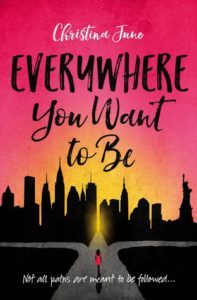 Everywhere You Want To Be by Christina June (May 1)
Everywhere You Want To Be by Christina June (May 1)
Matilda Castillo has always done what she was told, but when she gets injured senior years, she watches her dreams of becoming a contemporary dancer slip away. So when Tilly gets a once-in-a-lifetime opportunity to spend the summer with a New York dance troupe, nothing can stop her from saying yes–not her mother, not her fears of the big city, and not the commitment she made to Georgetown. Tilly’s mother allows her to go on two conditions: one, Tilly will regularly visit her abuela in New Jersey, and two, after the summer, she’ll give up dancing and go off to college.
Armed with her red vintage sunglasses and her pros and cons lists, Tilly strikes out, determined to turn a summer job into a career. Along the way she meets new friends … and new enemies. Tilly isn’t the only one desperate to dance, and fellow troupe member Sabrina Wolfrik intends to succeed at any cost. But despite dodging sabotage and blackmail attempts from Sabrina, Tilly can’t help but fall in love with the city, especially since Paolo, a handsome musician from her past, is also calling New York home for the summer.
As the weeks wind down and the competition with Sabrina heats up, Tilly’s future is on the line. She must decide whether to follow her mother’s path to Georgetown or leap into the unknown to pursue her own dreams.
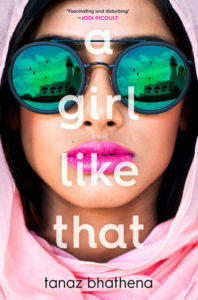 A Girl Like That by Tanaz Bhathena (February 27)
A Girl Like That by Tanaz Bhathena (February 27)
Sixteen-year-old Zarin Wadia is many things: a bright and vivacious student, an orphan, a risk taker. She’s also the kind of girl that parents warn their kids to stay away from: a troublemaker whose many romances are the subject of endless gossip at school. You don’t want to get involved with a girl like that, they say. So how is it that eighteen-year-old Porus Dumasia has only ever had eyes for her? And how did Zarin and Porus end up dead in a car together, crashed on the side of a highway in Jeddah, Saudi Arabia? When the religious police arrive on the scene, everything everyone thought they knew about Zarin is questioned. And as her story is pieced together, told through multiple perspectives, it becomes clear that she was far more than just a girl like that.
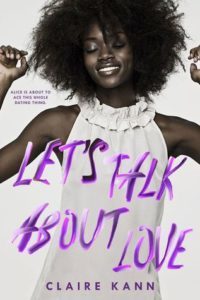 Let’s Talk About Love by Claire Kann (January 28)
Let’s Talk About Love by Claire Kann (January 28)
Alice had her whole summer planned. Non-stop all-you-can-eat buffets while marathoning her favorite TV shows (best friends totally included) with the smallest dash of adulting–working at the library to pay her share of the rent. The only thing missing from her perfect plan? Her girlfriend (who ended things when Alice confessed she’s asexual). Alice is done with dating–no thank you, do not pass go, stick a fork in her, done.
But then Alice meets Takumi and she can’t stop thinking about him or the rom com-grade romance feels she did not ask for (uncertainty, butterflies, and swoons, oh my!).
When her blissful summer takes an unexpected turn, and Takumi becomes her knight with a shiny library employee badge (close enough), Alice has to decide if she’s willing to risk their friendship for a love that might not be reciprocated—or understood.
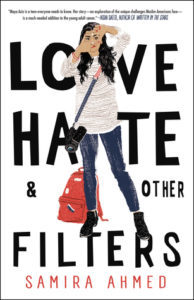 Love, Hate, and Other Filters by Samira Ahmed (January 16)
Love, Hate, and Other Filters by Samira Ahmed (January 16)
A searing #OwnVoices coming-of-age debut in which an Indian-American Muslim teen confronts Islamophobia and a reality she can neither explain nor escape–perfect for fans of Angie Thomas, Jacqueline Woodson, and Adam Silvera.
Maya Aziz is torn between futures: the one her parents expect for their good Indian daughter (i.e.; staying nearby in Chicago and being matched with a “suitable” Muslim boy), and the one where she goes to film school in New York City–and maybe, just maybe, kisses a guy she’s only known from afar. There’s the also the fun stuff, like laughing with her best friend Violet, making on-the-spot documentaries, sneaking away for private swimming lessons at a secret pond in the woods. But her world is shattered when a suicide bomber strikes in the American heartland; by chance, he shares Maya’s last name. What happens to the one Muslim family in town when their community is suddenly consumed with hatred and fear?
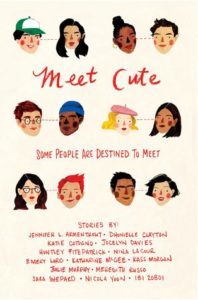 Meet Cute anthology by various YA authors (January 2)
Meet Cute anthology by various YA authors (January 2)
Whether or not you believe in fate, or luck, or love at first sight, every romance has to start somewhere. MEET CUTE is an anthology of original short stories featuring tales of “how they first met” from some of today’s most popular YA authors.
Readers will experience Nina LaCour’s beautifully written piece about two Bay Area girls meeting via a cranky customer service Tweet, Sara Shepard’s glossy tale about a magazine intern and a young rock star, Nicola Yoon’s imaginative take on break-ups and make-ups, Katie Cotugno’s story of two teens hiding out from the police at a house party, and Huntley Fitzpatrick’s charming love story that begins over iced teas at a diner. There’s futuristic flirting from Kass Morgan and Katharine McGee, a riveting transgender heroine from Meredith Russo, a subway missed connection moment from Jocelyn Davies, and a girl determined to get out of her small town from Ibi Zoboi. Jennifer Armentrout writes a sweet story about finding love from a missing library book, Emery Lord has a heartwarming and funny tale of two girls stuck in an airport, Dhonielle Clayton takes a thoughtful, speculate approach to pre-destined love, and Julie Murphy dreams up a fun twist on reality dating show contestants.
This incredibly talented group of authors brings us a collection of stories that are at turns romantic and witty, epic and everyday, heartbreaking and real.
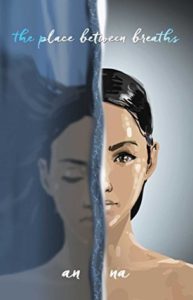 The Place Between Breaths by An Na (March 6)
The Place Between Breaths by An Na (March 6)
Sixteen-year-old Grace is in a race against time—and in a race for her life—even if she doesn’t realize it yet…
She is smart, responsible, and contending with more than what most teens ever have to. Her mother struggled with schizophrenia for years until, one day, she simply disappeared—fleeing in fear that she was going to hurt herself or those she cared about. Ever since, Grace’s father has worked as a recruiter at one of the leading labs dedicated to studying the disease, trying to lure the world’s top scientists to the faculty to find a cure, hoping against hope it can happen in time to help his wife if she is ever found. But this makes him distant. Consumed.
Grace, in turn, does her part, interning at the lab in the gene sequencing department in hopes that one day they might make a breakthrough…and one day they do. Grace stumbles upon a string of code that could be the key. But something inside of Grace has started to unravel. Could her discovery just be a cruel side effect of the schizophrenia finally taking hold? Can she even tell the difference between what is real and what isn’t?
 The Poet X by Elizabeth Acevedo (March 6)
The Poet X by Elizabeth Acevedo (March 6)
Xiomara Batista feels unheard and unable to hide in her Harlem neighborhood. Ever since her body grew into curves, she has learned to let her fists and her fierceness do the talking.
But Xiomara has plenty she wants to say, and she pours all her frustration and passion onto the pages of a leather notebook, reciting the words to herself like prayers—especially after she catches feelings for a boy in her bio class named Aman, who her family can never know about. With Mami’s determination to force her daughter to obey the laws of the church, Xiomara understands that her thoughts are best kept to herself.
So when she is invited to join her school’s slam poetry club, she doesn’t know how she could ever attend without her mami finding out, much less speak her words out loud. But still, she can’t stop thinking about performing her poems.
Because in the face of a world that may not want to hear her, Xiomara refuses to be silent.
Fans of Jacqueline Woodson, Meg Medina, and Jason Reynolds will fall hard for this astonishing own voices novel-in-verse by an award-winning slam poet, about an Afro-Latina heroine who tells her story with blazing words and powerful truth.
Ship It by Britta Lundin (Spring 18)
The story of a fanfic writer named Claire who just knows the two male characters on her favorite show are in love, and tries to convince the showrunner to make the relationship happen on screen when she’s invited on a Comic Con tour with the cast.
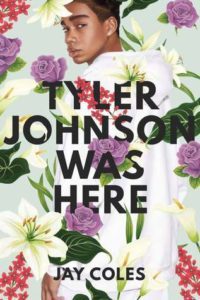 Tyler Johnson Was Here by Jay Coles (March 20)
Tyler Johnson Was Here by Jay Coles (March 20)
When Marvin Johnson’s twin, Tyler, goes to a party, Marvin decides to tag along to keep an eye on his brother. But what starts as harmless fun turns into a shooting, followed by a police raid.
The next day, Tyler has gone missing, and it’s up to Marvin to find him. But when Tyler is found dead, a video leaked online tells an even more chilling story: Tyler has been shot and killed by a police officer. Terrified as his mother unravels and mourning a brother who is now a hashtag, Marvin must learn what justice and freedom really mean.
September 15, 2017
Teacher Giveaway: brown girl dreaming and Last Stop On Market Street
Good Friday, everyone. I don’t know if you feel how I do, but this has been a very long week. One spot of bright news was meeting the goal of funding not only 33 classrooms on Donors Choose in honor of my birthday later this month, but reaching a goal of funding 56 classrooms, in honor of one of my editors, Elise Howard, who also celebrates a birthday very soon. To know we funded 56 class projects in a little over a month is incredible. That’s a lot of kids who’ll have books and school supplies, and all of those kids come from underprivileged backgrounds, so the message they’re getting is not only that they deserve these things, but that we see them and are eager to see them reach their fullest potentials. That they matter.
Over the course of the project, a number of different people have reached out asking if they can donate or give to the cause. Today, I’m sharing an opportunity for teachers to receive one of two books for their classroom.
Thanks to Penguin Young Readers, I have 17 copies of Last Stop on Market Street by Matt de la Pena and Christian Robinson, as well as 16 copies of brown girl dreaming by Jacqueline Woodson.
This giveaway will allow teachers to enter for ONE copy of EITHER book. I’ll let it run until all copies are claimed. In order to claim a copy, I need either a school email address for your entry or the mailing address of the school for which you teach. Ideally, these will be classrooms in need, so please, if you can afford to bypass this giveaway, that would be rad. You know your kids and your school, so I’ll trust your judgment!
I will email all winners when the copies have been claimed so you can know to expect a book.
Loading…
September 14, 2017
This Week at Book Riot
Over on Book Riot this week (and last):
A look at this year’s young adult books in translation.
40 YA paperbacks hitting shelves this fall.
A massive round-up of bookish gifts for fans of Stephen King’s It.
YA books featuring teens who have unusual, odd, and fun jobs.
September 12, 2017
Cormoran Strike by Robert Galbraith
I used to read tons of adult mysteries, from the time I was a tween all the way up through grad school in my early twenties. Both of my parents were really into them, so we listened to lots of (mostly) kid-friendly titles on long car trips. Elizabeth Peters, Alexander McCall Smith, and Janet Evanovich were a few favorites. As an adult, I loved reading Elizabeth George, Alan Bradley, and Deanna Raybourn.
And then my deep dive into the world of YA happened, and my focus shifted to mainly YA SFF. I’d always read a lot of science fiction and fantasy, but I didn’t touch another genre for quite some time. It’s only recently that I’ve drifted back into adult mysteries, and I have J.K. Rowling to thank for it.
Under the pseudonym Robert Galbraith, she’s written a series of three mysteries (so far) featuring private detective Cormoran Strike (a very Harry Potter-ish name). And they are really, really good. Rowling’s plotting of the Harry Potter series has always been one of its main joys for me, so it makes total sense that she’d rock writing mysteries. The plots of the Strike books are complex, sometimes convoluted, with red herrings galore, but always, always a solution that makes complete sense and ties up all the myriad clues.
And of course, a good mystery series features a dynamic, interesting lead detective. In the Strike series, we get two: private detective Cormoran Strike and his assistant, Robin Ellacott, who was initially assigned to him as a secretary through a temp agency. She quickly proves herself to have a knack for detective work, and the two make a great team. Their relationship has its ups and downs – Cormoran doesn’t always value her as he should, and Robin is often unsure of herself and her new role, leading to miscommunications – but it’s one of the joys of reading the books. Cormoran himself has a fascinating backstory (son of a famous rockstar and a groupie, lost his leg in Afghanistan) that Rowling/Galbraith teases out through the three novels currently published. Robin, too, has a backstory, arguably equally tragic, but the focus with her is usually on her current troubles (an awful fiance who wants her to give up detective work).
I listened to these on audiobook, and the narrator, Robert Glenister, is fantastic, one of the best in the business. He partly voices each character, and the pace of his narration is terrific – no need to speed him up like so many other audiobook narrators. He is the voice of Cormoran Strike for me, and he even does the women pretty well – they’re not breathy or weirdly high-pitched like male narrators often do for female characters.
The three currently published books have been adapted for a BBC television series, which has already begun airing in the UK. HBO has picked it up for distribution, but there’s not yet a release date stateside. The fourth novel in the series, Lethal White, should be out sometime in 2018 (Rowling hasn’t finished writing it yet). If you’re in the mood for a really well-done contemporary mystery series, this is a great pick.
September 11, 2017
Anatomy of an Anthology: HERE WE ARE: FEMINISM FOR THE REAL WORLD edited by Kelly Jensen
To launch the “Anatomy of an Anthology” series, I’ll start with a look at the hows and whys of putting together Here We Are: Feminism For The Real World.
Kelly Jensen
Your Anthology’s Name
Here We Are: Feminism For The Real World
Anthology Description
Here We Are is a scrapbook-style teen guide to understanding what it really means to be a feminist. It’s packed with essays, lists, poems, comics, and illustrations from a diverse range of voices, including TV, film, and pop-culture celebrities and public figures such as ballet dancer Michaela DePrince and her sister Mia, politician Wendy Davis, as well as popular YA authors like Nova Ren Suma, Malinda Lo, Brandy Colbert, Courtney Summers, and many more. Altogether, the book features more than forty-four pieces, with an eight-page insert of full-color illustrations.
Here We Are is a response to lively discussions about the true meaning of feminism on social media and across popular culture and is an invitation to one of the most important, life-changing, and exciting parties around.
How did you get your idea/what was the initial spark?
My spark for the anthology came after years of feminism discussion online, both through blogs and social media. I’d had this idea simmering for a long time, but had no idea how or where to begin with it.
Where did you begin researching your idea and/or developing the idea into a more clear, focused concept?
I’d thrown out two tweets a few months apart about my dream project being an anthology of essays about feminism for teen readers. During the second tweet, one of my editors saw it, and she asked some of her current authors to be in touch with me and tell me to reach out to her.
I talked with both her and my other editor on the phone not long after that, where we talked about what such a project could look like. I put together a lengthy proposal based on my ideas and what we’d discussed in the call.
What steps did you take from idea to proposal?
My process for this anthology was completely nontraditional, which is interesting to think about since my second anthology’s process has been so different (but that’s another post for another day!). Once I got on the phone with my editors, we talked about tone, about the presentation and design, and about how we could make this much bigger than a book form of a Twitter echo chamber. That involved thinking beyond YA writers and including “big names” and celebrity pieces into the collection.
Step one was the idea. Step two was the phone call. Step three was a lot of thinking and outlining — I definitely spent a few weeks really thinking hard, which sometimes looked like doing “nothing,” though it was a lot of online and offline research. Step four was a formal proposal.
What was included in your proposal to your publisher?
My proposal included a proposed title (which changed!), an estimated word count, a quick summary and framing idea (that feminism is a party you want to join). From there, I wrote an introduction for the anthology, which eventually got scrapped, and then I put together a general outline for the collection. I included a huge list of potential people to reach out to and possible topics they might cover. But I’ve said this over and over: those were my ideas for them, and I left the topic they wrote about 100% up to them. My ideas were for if they became stuck, and it was brilliant that none of them needed help. They had ideas and they ran with them.
Also included in my proposal, and something I cannot recommend highly enough, was the letter I drafted for those I wanted to reach out to for contributions. It allowed me to think about the anthology from the writer’s perspective, rather than the editor’s perspective, and it made reaching out go so much faster. It was a formatted letter, but it left me plenty of room for personalizing because I did reach out to each contributor for very specific reasons: their voice, their POV, the sorts of things they’ve said or thought about that would add depth to the collection.
Did you use an agent? If you didn’t use an agent, how did you find a publisher?
Not for Here We Are. My editors found me!
How did you find your writers?
This was part of my “research” and “proposal” work. I did a lot of reading and researching online and off. I found voices I loved and perspectives I thought might challenge myself as an editor and challenge readers of the collection. Some were people I knew well and who I felt might be pretty certain to say they wanted in. Others were people I’d dreamed of working with but had never talked to.
The key was being familiar with each person’s work. That took time and energy and it was absolutely worth it. That helped me gain a stronger editorial eye and think about how to frame the collection.
How did writers pick their story or essay topic ideas? What process did you as editor use to vet them?
Writers all selected their own topic. This was crucial to me. I loathe the idea that someone is in a collection because they fit somewhere on a diversity checkbox. People are way more than the labels they take for themselves. But no matter what it is they write, those identities are impossible to pull out of their perspective. One of the criticisms I’ve seen of Here We Are is that there’s no asexual representation. This is actually untrue: there’s more than one asexual writer, but those writers chose NOT to write about that. As an editor, it wasn’t my job to tell them to write about that nor was it my job to either force them to put it in their biography or for me to out them when that criticism appeared. I know what I know, and my writers know what they know. There’s a big trust factor that goes into it, and I trust both sides here to do what’s best.
For vetting, I asked my writers to get me a general idea of the topic they wanted to tackle, and then they sent me a 2-3 sentence pitch. I looked to make sure there wasn’t overlap, and in one instance, a topic had a lot of interest. I asked a couple writers to think bigger or think about other potential angles, and the results were fabulous.
As an editor, were you responsible for contracts between you and your writers? Did your publisher or agent handle the administrative/legal side of things?
I had a contract between myself and my publisher. I was responsible for having and coordinating contracts between myself and the writers. These contracts covered their legal rights, as well as what they were delivering and the payment they’d receive. This part of the process was very, very challenging, since I knew so little about contracts and couldn’t answer a lot of the questions that came to me. I relied a lot on my editors to help me through the process, which….I was lucky they were there to help, since they didn’t have to be and because, just as is a matter of course, they play for the house, rather than the author. It was mentioned to me during this process I should consider getting an agent since an agent plays for my best interests. I was lucky to get an excellent agent shortly after that.
The nitty gritty details of the contracts: Algonquin gave me both a fresh contract and a contract for reprints to use with my writers. Those had to be revised a few times, but they were pretty standard and straightforward.
How did the editing process work between you and your writers?
I used varying processes depending on the writer. But the basic framework went like this: they wrote, then they sent me a draft, I’d read it a few times, then I’d read it with an editing eye. I’d put it away for a couple of days and revisit it with new eyes and add any further comments I had. The draft went back to them, they’d revise, and the process played itself out again.
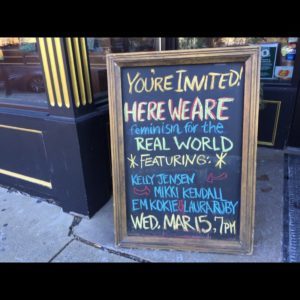 Some writers wanted more input than others, and I worked with each of them at the level they wanted. I kind of loved having that ability: it was neat to see some writers who wanted no input from me turn in these beautiful drafts as much as it was neat to see a writer have a seed of an idea, seek my input, draft, come back for more input, draft some more, and then turn in something we could really mold into a beautiful piece.
Some writers wanted more input than others, and I worked with each of them at the level they wanted. I kind of loved having that ability: it was neat to see some writers who wanted no input from me turn in these beautiful drafts as much as it was neat to see a writer have a seed of an idea, seek my input, draft, come back for more input, draft some more, and then turn in something we could really mold into a beautiful piece.
I believe anyone with a great idea and voice can write an essay, which is why I was able to have such a wide range of contributors beyond professional writers. You can’t create the ideas or the voice, but you can work together to mold the writing itself. I like to think everyone was happy with their final pieces and that they enjoyed the experience. I know I loved seeing the end products of both those who needed little of my thoughts and those who sought a lot.
One of the biggest things in editing this anthology for me was asking questions. I am a commenter when I edit, highlighting what I loved and what I think could be strengthened or cut. But I’m also someone who doesn’t know everything and having to be humble and ask questions of my writers — the ones who were the experts in their own topics and experiences — made me better understand where they were coming from and better able, in the long run, to talk about their pieces. I found asking questions made the process much more seamless, since it allowed a dialog to open up, wherein I listened, rather than said what I thought was best.
Money talk: how did you get paid for your work?
Algonquin gave me a three-part advance: the first came upon signing, the second came upon my final contributor list, and the third came upon delivery and acceptance of the manuscript. The second and third, in this case, came at the same time.
How did your writers get paid?
I didn’t do this particularly well for Here We Are. I had people being paid a little bit of everything, with nearly everyone getting the same amount but some getting more because, contractually, they had a clause in there that allowed it to happen. Likewise, when I approached some for reprints, the cost to reprint was higher than what I’d been paying as a standard rate. But every single contributor got paid, and that’s a thing I’m really proud of.
As far as the how of it, I was responsible for paying my writers, not my publisher. That meant the second and third part of my advance? That all went to my writers.
In the interest of total transparency: I walked away with very little of my own advance money, since I paid so many to be part of this. I don’t regret it, though it taught me a lot about being smarter in future projects.
How did you communicate with your writers? What sort of information did you share with them and how?
Most communication was one-on-one, though I sent out periodic (about once a month) emails to all contributors with updates about where we were in the process. When it was closer to pub date, more communication happened, mostly to share the great reviews the book was receiving.
I used a private BCC method of emailing to keep everyone’s information separate. I did this for communicating that information to them, but also to solicit information from them (i.e., how they preferred to get paid or have copy edits handled).
Where and how did you decide to include your own work in the collection?
I had no intention of putting my own work in the anthology, but as the book was coming together, I realized I had something to add that hadn’t been addressed before. It only made sense to me to use the opportunity to write and share that. I don’t regret it at all, and I really am glad I could make it the last piece of the collection, since I think it captured a lot of the spirit of many other pieces.
Where and how did you come to “direct” the anthology? Did you have an idea of how you wanted pieces to progress early on or did you wait until all pieces were available to you to begin constructing the collection?
I had a rough idea of what sorts of topics I wanted to see covered, but since I let writers choose what they talked about, I couldn’t necessarily direct the organization nor flow early on. What I ended up choosing to do was waiting until I knew what the pieces were from each of the writers, and then I made up index cards with the topics and authors and made a lot of outlines with them on the floor. It was nice to see how well a lot of topics fit with one another, though there were a number of pieces I had to think long and hard about in terms of where they’d shine best.
Something I’d read a long time ago — and I don’t think it’s true — is that anthologies often start with their strongest piece and hide weaker pieces in the middle. Here’s the thing: none of the pieces in this collection were weak, and it was really challenging to figure out where to put everything because everything had great value. So it took a long time to figure out where and how to start the collection and then how to let the story unfold in a way that made sense and allowed each piece its moment.
Back in college, my final capstone project for my English major was about anthologies. We talked deep about the politics of putting them together, and along with having to create one for a grade, we had to write a number of papers that explored the choices an editor had made in collections that were available. I used a lot of what I learned in that class to think about how a reader might look at Here We Are: will they see themselves? Will they see me as editor in there too much? What does it say when I include this piece in this particular category and another piece in a different one? How important is back matter to the collection (which was a conversation that my editors and I had more than once).
I knew early on I wanted my voice as minimal as possible. This is why the section introductions are so short, why there are simply “FAQ” sections throughout to explain some terminology, and why I chose to put simple back matter and my essay at the end of the collection. I was here to help other voices shine, not make mine the starring role.
How involved was your editor/publisher throughout the creation process, prior to turning in a manuscript?
There was a lot of help through the contract stages, but less through the process. I kept them aware of where I was in my editing, but until they had the manuscript in hand, I didn’t reach out for much beyond “how do I answer this contract question?” I also asked a lot of questions about how images and color would work, since I had art to include and had no idea how that would work.
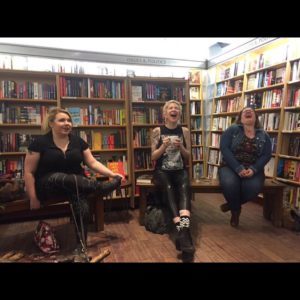 When the manuscript was a complete draft, what was the process when you passed it on to your editor/publisher?
When the manuscript was a complete draft, what was the process when you passed it on to your editor/publisher?
I sent them an excited email with the draft, and then I waited to hear their comments. The editorial letter I got was pretty short, with just a couple of “big picture” things to think about and work with. That was super helpful, and it really helped guide my next round of edits with writers.
Not all of the edits I agreed with nor did my writers agree with. This was where my role as editor of the anthology really came to play. I heard and listened to both sides, and then helped a resolution come. In some instances, it meant saying that something wasn’t going to change or it meant helping a writer reframe a piece a little bit.
How did you communicate changes and/or concerns between writer and your editor/publisher?
I was open on both sides and served as an intermediary. I had a couple writers concerned about edits they’d received — both in big picture edits and in copyedits — and I did my best to resolve those on both sides. I think it helped a lot that I’d been open and available throughout the entire editorial process, so they knew they could express something to me and see it resolved in a satisfactory way.
To be honest, there were very few big edits, though, that required communication or solving. Part of being a writer is standing up for your choices and part of being an editor is suggesting places to make a piece of writing better. When you have an open line of communication, it’s easy to see what choices might make the work strongest without either ego getting too big or hurt. And sometimes, it was a matter of me hearing a writer say “nah, I’m not doing that” and accepting they know best.
When it came to the package of your anthology, how much say did you have in the cover or design? How much were contributors involved in that part of the process?
I knew it would be highly designed and when I saw the cover and the concept, I loved both. I believe I said “holy shit” to my editors upon seeing them.
I was very uninvolved and I liked being able to trust my publishing team knew best. They did!
Contributors weren’t involved at all in that part of the process.
What was your favorite part of the anthology creation process?
I loved seeing pieces go from seed to full fledged beautiful tree. Some of those pieces we worked on for a long time and the way they came out was so satisfying.
What was your least favorite part?
Contracts!
What were some of the biggest lessons you as an editor learned in creating an anthology?
I learned better management of money for the second anthology, as well as learned a bit more about how to manage a huge project. I feel like my second anthology was actually harder, but again, another post for another day. Here We Are taught me a lot about how books are made, how decisions are made, and how to create something out of nothing. Cliche, but true.
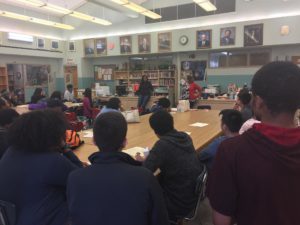 What were some of the biggest successes?
What were some of the biggest successes?
I was in New York City for Book Riot Live last November and had just gotten lunch with one of my editors. Immediately after that lunch, I walked to The Strand to do some browsing. My phone rang and it was a NYC area code, which is one of the few things I’ll pick up an unknown number for. It was the editor I’d just had lunch with, and she had news for me. It was the first trade review, from Kirkus, and it was a star. She read it to me while I hid out in the paper/stationary area of The Strand and tears streamed down my face. It was an incredible moment, and I ended up leaving The Strand pretty much immediately, getting a cab back to my hotel, and then emailing all the contributors with the news, since so many of their pieces were praised.
I loved doing the book tour, too, and getting to sit on a number of panels with contributors.
Perhaps the thing that sticks out most, though, was getting to do a 3 hour (!!) school visit at a high school in Milwaukee with Mikki Kendall, where we heard all kinds of questions from kids who were just so eager to talk, to be heard, and to learn about feminism. Not only did that feel good, but I learned an unbelievable amount from both Mikki and those kids. It changed how I chose to talk about the anthology and gave me a lot to chew on in terms of my own feminism.
What, if any, anthologies did you read while putting together your own? What anthologies had you looked at to help you on your own work?
I actually avoided reading any anthologies. I read a few essay collections, which ended up being helpful to me for finding new voices to consider. Alida Nugent’s You Don’t Have To Like Me led me to reach out to her and have a fabulous experience with a new-to-me writer.
In terms of other anthologies I looked at: I didn’t. There are very few nonfiction anthologies for YA readers, and the one I knew about, Amber J. Keyser’s The V Word, I had been a contributor to, and thus, knew a bit about. Fiction anthologies are an entirely different beast, so I read them for me, rather than for inspiration.
If you are working on another anthology, what made you want to try your hand at it again? What, if any, parts of the process are/were different in the next project?
I knew when I was reading through Anne Theriault’s essay in Here We Are that an entire anthology around mental health was something that I wanted to consider as a next project. Her piece really moved me, and it made me think a lot about my own mental health journey. Had I a resource as a teen, I wonder how much different my own experiences with my mental health would have been. It was from there I decided it was worth a shot!
As far as what’s different: there is a much heavier emotional weight to bear for this one. That wasn’t something I expected, even though I should have. The pieces are outstanding, and they’re going to be powerful for young readers. But as an editor, it has been so hard to look at the raw emotions of a piece and separate them from the craft itself. It took a lot of false starts to get into a solid groove, and I had to be patient with myself, allowing space where necessary.

